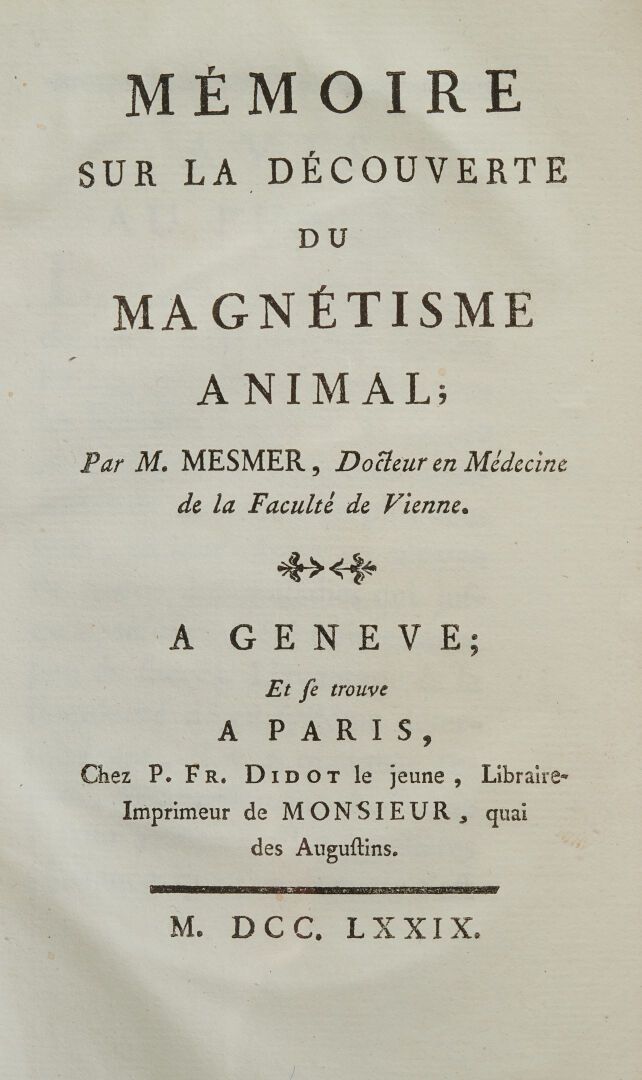Description
MESMER (Franz-Anton). Memoir on the discovery of animal magnetism. À Genève ; et se trouve à Paris, chez P. Fr. Didot le jeune, 1779. Small in-8, marbled half-brown calf, smooth spine cloisonné and fleuronné with garnet-red title page (contemporary binding). MESMER: (2 of which the second blank)-vi-85-(3 blanks) pp. some marginal wetness. - ESLON: (4 of which the 2nd and 4th are blank)-151-(one blank) pp.; tear to title-piece, marginal wetness. FIRST EDITION. THE FOUNDING TREATY OF MESMERISM, containing the first complete formulation of this theory and the detailed account of many years of medical practice (Norman, M4, "The manifesto of animal magnetism"). AUSTRIAN PHYSICIAN AND FREEMASON FRANZ ANTON MESMER (1734-1815). Author of a controversial theory of animal magnetism that led to original therapeutic practices (magnetic passes producing trances). By proposing a new approach to nervous disorders, he paved the way for psychosomatic medicine and hypnosis, and heralded the work of Charcot and Freud. He practiced successfully in Vienna and then Paris, before taking refuge in Switzerland during the French Revolution, where he became a Swiss citizen. INNOVATIVE THERAPEUTIC TECHNIQUES FOR NERVOUS DISORDERS. Although Mesmer's theory of "animal magnetism" was shown to be false in its day (by a commission of scientists including Franklin and Lavoisier), it offered a new approach to nervous disorders and had a major impact on the history of science and literature. It paved the way for the work of James Braid, Jean Martin Charcot (and hence Sigmund Freud), and was echoed in the works of E.T.A. Hoffmann, Victor Hugo and Edgar Poe. "Considered as a movement, mesmerism suggests some of the varieties of pre-Romanticism and popular science in the late eighteenth century. It did not spend itself as an intellectual force for almost a hundred years [...]. In terms of the development of medicine, the techniques of mesmerizing proved more influential than its theory [...]. In the nineteenth century hypnosis, shorn of Mesmer's cosmology and perfected by James Braid and J. M. Charcot, became an accepted medical practice." (DSB, IX, p. 327). "Mesmer became, unwittingly, a pioneer of psychotherapy [...]. Jung was particularly close to mesmerism in his belief that consciousness could transcend time and space"). (PMM, no. 225). RELATED TO THE SUITE : ESLON (Charles d'). Observations on animal magnetism. À Londres ; et se trouve à Paris, chez P. Fr. Didot, le jeune, C. M. Saugrain, Clousier, 1780. Small in-8, marbled brown half calf, smooth spine with cloisonné and fleuronné decoration and garnet-red title page. Unknown edition in the Norman catalog, which cites the 1781 Karlsruhe edition as the original. THE FIRST SCIENTIST OF RENOWN TO CONVERT TO MESMERISM, CHARLES D'ESLON (1750-1786) was a doctor-regent of the Paris Faculty of Medicine, and the first ordinary physician to the Count of Artois. However, he encountered strong opposition within the Faculty and was expelled. He also broke with Mesmer and developed his own theory of animal magnetism. It was his method that the Royal Commission came to examine, not Mesmer's.
96
MESMER (Franz-Anton). Memoir on the discovery of animal magnetism. À Genève ; et se trouve à Paris, chez P. Fr. Didot le jeune, 1779. Small in-8, marbled half-brown calf, smooth spine cloisonné and fleuronné with garnet-red title page (contemporary binding). MESMER: (2 of which the second blank)-vi-85-(3 blanks) pp. some marginal wetness. - ESLON: (4 of which the 2nd and 4th are blank)-151-(one blank) pp.; tear to title-piece, marginal wetness. FIRST EDITION. THE FOUNDING TREATY OF MESMERISM, containing the first complete formulation of this theory and the detailed account of many years of medical practice (Norman, M4, "The manifesto of animal magnetism"). AUSTRIAN PHYSICIAN AND FREEMASON FRANZ ANTON MESMER (1734-1815). Author of a controversial theory of animal magnetism that led to original therapeutic practices (magnetic passes producing trances). By proposing a new approach to nervous disorders, he paved the way for psychosomatic medicine and hypnosis, and heralded the work of Charcot and Freud. He practiced successfully in Vienna and then Paris, before taking refuge in Switzerland during the French Revolution, where he became a Swiss citizen. INNOVATIVE THERAPEUTIC TECHNIQUES FOR NERVOUS DISORDERS. Although Mesmer's theory of "animal magnetism" was shown to be false in its day (by a commission of scientists including Franklin and Lavoisier), it offered a new approach to nervous disorders and had a major impact on the history of science and literature. It paved the way for the work of James Braid, Jean Martin Charcot (and hence Sigmund Freud), and was echoed in the works of E.T.A. Hoffmann, Victor Hugo and Edgar Poe. "Considered as a movement, mesmerism suggests some of the varieties of pre-Romanticism and popular science in the late eighteenth century. It did not spend itself as an intellectual force for almost a hundred years [...]. In terms of the development of medicine, the techniques of mesmerizing proved more influential than its theory [...]. In the nineteenth century hypnosis, shorn of Mesmer's cosmology and perfected by James Braid and J. M. Charcot, became an accepted medical practice." (DSB, IX, p. 327). "Mesmer became, unwittingly, a pioneer of psychotherapy [...]. Jung was particularly close to mesmerism in his belief that consciousness could transcend time and space"). (PMM, no. 225). RELATED TO THE SUITE : ESLON (Charles d'). Observations on animal magnetism. À Londres ; et se trouve à Paris, chez P. Fr. Didot, le jeune, C. M. Saugrain, Clousier, 1780. Small in-8, marbled brown half calf, smooth spine with cloisonné and fleuronné decoration and garnet-red title page. Unknown edition in the Norman catalog, which cites the 1781 Karlsruhe edition as the original. THE FIRST SCIENTIST OF RENOWN TO CONVERT TO MESMERISM, CHARLES D'ESLON (1750-1786) was a doctor-regent of the Paris Faculty of Medicine, and the first ordinary physician to the Count of Artois. However, he encountered strong opposition within the Faculty and was expelled. He also broke with Mesmer and developed his own theory of animal magnetism. It was his method that the Royal Commission came to examine, not Mesmer's.
